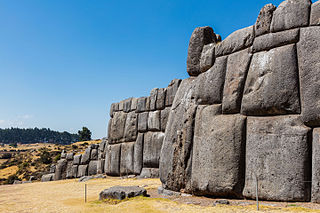
Cusco or Cuzco is a city in southeastern Peru, near the Sacred Valley of the Andes mountain range and the Huatanay river. It is the capital of the eponymous province and department. The city is the seventh most populous in Peru; in 2017, it had a population of 428,450. Its elevation is around 3,400 m (11,200 ft).

Inca Garcilaso de la Vega, born Gómez Suárez de Figueroa and known as El Inca, was a chronicler and writer born in the Viceroyalty of Peru. Sailing to Spain at 21, he was educated informally there, where he lived and worked the rest of his life. The natural son of a Spanish conquistador and an Inca noblewoman born in the early years of the conquest, he is known primarily for his chronicles of Inca history, culture, and society. His work was widely read in Europe, influential and well received. It was the first literature by an author born in the Americas to enter the western canon.

Estadio de la UNSA is a multi-purpose stadium located in Arequipa, Peru. The stadium was built by the University of San Agustín in the early 1990s and named after the Virgin Chapi. Due to its size, the term Monumental is added to its name. The stadium was largely financed by a lottery fund-raiser held by the university itself. It is the biggest stadium in Arequipa and the second one in Peru after the Estadio Monumental U in Lima. The stadium has hosted large events such as the Bolivarian Games and the Copa América in addition to a Copa Sudamericana final in 2003 involving Cienciano and River Plate. The stadium's allowed spectator capacity is currently 60,370.

The National Stadium of Peru is a multi-purpose stadium located in Lima, Peru. Its current capacity is 50,086 seats as stated by the Peruvian Football Federation without the lodges for some thousands more. The stadium was first inaugurated on 27 October 1952 for the 1953 South American Championship—replacing the Stadium Nacional—and is Peru's principal and national stadium. It has hosted three of the six South American Championship/Copa América football competitions held in Peru. It is referred to as the Coloso de José Díaz because of its proximity to a street of the same name.

Foot Ball Club Melgar, known simply as FBC Melgar or Melgar, is a Peruvian professional football club based in Arequipa, Peru. It is one of Peru's oldest football teams, founded in 1915 under the name Juventud Melgar by a group of football enthusiasts from Arequipa. The club currently participates in the Peruvian Primera División, the top tier of Peruvian football.

Club Cienciano, more commonly known as Cienciano, is a Peruvian professional football club based in Cusco, that currently plays in the Peruvian Primera División. It gained worldwide recognition after defeating River Plate in the finals of the 2003 Copa Sudamericana and Boca Juniors in the 2004 Recopa Sudamericana. The club is considered the largest and most successful in Cusco. Founded in 1901, the club is among the oldest in Peru and the oldest in Cusco.

The Estadio Monumental is a football Stadium in Macul, south-east of the centre of the Chilean capital Santiago. It serves as the home ground of Colo-Colo, and on occasions also for other clubs and the national football team. The stadium has a current spectator capacity of 47,347. The actual playing field is named after David Arellano, the founder of Colo-Colo; therefore, on occasions the whole stadium is referred to as Estadio Monumental David Arellano.

Estadio Alberto Gallardo is a football stadium in the Rimac District of Lima, Peru, named after Alberto Gallardo, a former Peruvian football player and manager who played for several years for Sporting Cristal. It is the home of football club Sporting Cristal. The stadium was built in the 1960s along the Rímac River for local football use and was originally named Estadio San Martín de Porres. Many clubs playing in the Primera División, Segunda División, and district leagues of San Martín de Porres were among the many tenants the stadium had. In 1995, Sporting Cristal—one of the regular first division tenants of the stadium—decided to lease the venue from the Instituto Peruano del Deporte for 17 years. In 2012 the club signed a new lease contract for 10 years which will expire in 2022. The stadium itself has hosted a few high-risk matches due to the limited access to the stadium and the low capacity of 11,600.

Estadio Capitán Remigio Elías Aguirre Romero is a multi-purpose stadium administrated by the governmental Instituto Peruano del Deporte in Chiclayo, Peru. It was built in 1970 named after the 19th century Peruvian sailor Elías Aguirre Romero. Its current spectator capacity is 23,000 after the renovations performed for the 2004 Copa América, and had artificial turf installed for the 2005 FIFA U-17 World Championship. The most recognized club to play at this stadium is Juan Aurich.

The Peru First Division, officially known as Liga 1, is the top flight of association football in Peru. It has been referred to as Torneo Descentralizado since 1966, when the first teams residing outside the Lima and Callao provinces were invited to compete in the inaugural league national competition.
The 2001 Torneo Descentralizado, was the 85th season of the top category of Peruvian football (soccer). It was played by 12 teams. The national champion was Alianza Lima.

Club Deportivo Garcilaso, most commonly known as Deportivo Garcilaso, or El Garci, is a Peruvian professional football club, based in the city of Cusco. Founded in 1957, the club competes in the Peruvian Primera División, after being promoted by winning the 2022 Copa Perú.

Cusco Fútbol Club, commonly known as Cusco, or Cusco FC, is a professional Peruvian football club based in the city of Cusco, that currently competes in the Peruvian Primera División, the top flight of Peruvian football. It was founded on 28 August 2008 as Real Garcilaso, changing their name to Cusco FC in 2019.
Ramón Rodríguez del Solar is a Peruvian footballer who plays as a striker for Santa Rosa in the Torneo Descentralizado. In his long career, Rodríguez has played for the likes of Cienciano, FBC Melgar, Total Clean, Deportivo Municipal, Sport Boys, Alianza Atlético, Inti Gas Deportes, and Cobresol and Real Garcilaso. His nicknamed is El Ratón
The 2015 Torneo del Inca is the third season of the Torneo del Inca, the first football tournament of the 2015 season of Peruvian football. All 17 teams of the first division compete in this tournament and the winner of the tournament advances to the playoffs of the 2015 Torneo Descentralizado.
Raúl Alexánder Tito Cano is a Peruvian professional footballer who plays as a winger for Peruvian club Deportivo Garcilaso.
The 2022 Copa Sudamericana first stage was played from 8 to 17 March 2022. A total of 32 teams competed in the first stage to decide 16 of the 32 places in the group stage of the 2022 Copa Sudamericana.

Estadio Guillermo Briceño Rosamedina is a football stadium located in Juliaca, Peru. It has a capacity of 20,030 spectators and is home to local club, Deportivo Binacional, who got relegated to the Peruvian Segunda División in 2023 after their time in the Peruvian Primera División.














